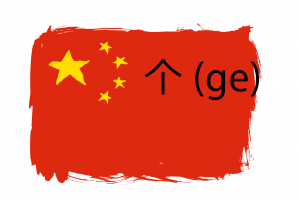Difference between revisions of "Language/Mandarin-chinese/Grammar/个-(ge)"
< Language | Mandarin-chinese | Grammar
Jump to navigation
Jump to search
m (Quick edit) |
|||
| (One intermediate revision by the same user not shown) | |||
| Line 1: | Line 1: | ||
[[File:个 (ge).png|thumb]] | [[File:个 (ge).png|thumb]] | ||
<div | <div class="pg_page_title">The classifier <code>個/个</code> (ge)</div> | ||
The classifier <code>個/个</code> (ge) is the most common classifier in Chinese. It can be used for all names if you do not know specific classifiers for a word (although you will not look particularly scholarly, you will still be able to use it). | The classifier <code>個/个</code> (ge) is the most common classifier in Chinese. It can be used for all names if you do not know specific classifiers for a word (although you will not look particularly scholarly, you will still be able to use it). | ||
| Line 11: | Line 10: | ||
==Examples== | ==Examples== | ||
*<span class="notranslate">一 <code>個</code> 球/一 <code>个</code> 球 yí gè qiú</span> | *<span class="notranslate">一 <code>個</code> 球/一 <code>个</code> 球 yí gè qiú</span> | ||
| Line 27: | Line 25: | ||
*<span class="notranslate">五 <code>個</code> 星期/五 <code>个</code> 星期 wǔ gè xīngqī</span> | *<span class="notranslate">五 <code>個</code> 星期/五 <code>个</code> 星期 wǔ gè xīngqī</span> | ||
<blockquote>five weeks</blockquote> | <blockquote>five weeks</blockquote> | ||
==Other Lessons== | |||
* [[Language/Mandarin-chinese/Grammar/了-le|了 le]] | |||
* [[Language/Mandarin-chinese/Grammar/Questions-with-不-(bù)|Questions with 不 (bù)]] | |||
* [[Language/Mandarin-chinese/Grammar/Basic-structure-of-a-sentence|Basic structure of a sentence]] | |||
* [[Language/Mandarin-chinese/Grammar/Ask-for-directions-in-Chinese|Ask for directions in Chinese]] | |||
* [[Language/Mandarin-chinese/Grammar/也-yě|也 yě]] | |||
* [[Language/Mandarin-chinese/Grammar/Adjectives|Adjectives]] | |||
* [[Language/Mandarin-chinese/Grammar/Transition-words|Transition words]] | |||
* [[Language/Mandarin-chinese/Grammar/Mastering-Chinese-Grammar-Easily-–-8-Rules-You-Need-to-Know|Mastering Chinese Grammar Easily – 8 Rules You Need to Know]] | |||
* [[Language/Mandarin-chinese/Grammar/Conditional-Mood|Conditional Mood]] | |||
* [[Language/Mandarin-chinese/Grammar/Future-Tense|Future Tense]] | |||
<span links></span> | |||
Latest revision as of 23:07, 26 March 2023
The classifier
個/个 (ge)The classifier 個/个 (ge) is the most common classifier in Chinese. It can be used for all names if you do not know specific classifiers for a word (although you will not look particularly scholarly, you will still be able to use it).
Structure[edit | edit source]
The general structure for 個/个 (ge) - and classifiers in general - is:
Number + 個/个 + Name
You can specify the quantity of all names with this structure. Note that whenever you want to express "how much" is there a unit of the same name in Chinese, you will probably need a classifier. For starters, get used to 個/个 (ge).
Examples[edit | edit source]
- 一
個球/一个球 yí gè qiú
a ball
- 兩
個人/两个人 liǎng gè rén
two people
- 三
個蘋果/三个苹果 sān gè píngguǒ
three apples
- 四
個三明治/四个三明治 sì gè sānmíngzhì
four sandwiches
- 五
個星期/五个星期 wǔ gè xīngqī
five weeks
Other Lessons[edit | edit source]
- 了 le
- Questions with 不 (bù)
- Basic structure of a sentence
- Ask for directions in Chinese
- 也 yě
- Adjectives
- Transition words
- Mastering Chinese Grammar Easily – 8 Rules You Need to Know
- Conditional Mood
- Future Tense
